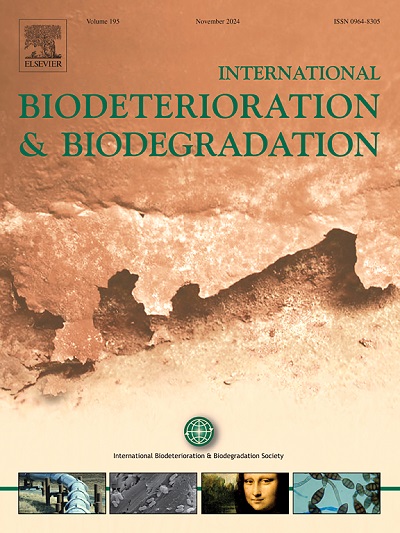Biodeterioration of cultural heritage monuments: A review of their deterioration mechanisms and conservation
IF 4.1
2区 环境科学与生态学
Q2 BIOTECHNOLOGY & APPLIED MICROBIOLOGY
International Biodeterioration & Biodegradation
Pub Date : 2025-03-17
DOI:10.1016/j.ibiod.2025.106066
引用次数: 0
Abstract
Geochemical cycles result in the chemical, physical, and mineralogical modification of rocks, ultimately leading to the formation of soil. However, when stones and rocks form part of historic buildings and monuments, the effects are deleterious. In addition, microorganisms colonize these monuments over time, resulting in the formation of biofilms, while microbial metabolites cause physical weakening and discoloration of the stone. This process, known as biodeterioration, results in a significant loss of cultural heritage. Purification and 16S rDNA sequencing of bacteria growing on heritage monuments revealed that the most prominent taxa were closely related to Bacillus spp., Arthrobacter spp., Staphylococcus spp. and Paenibacillus spp. In addition to bacteria, some fungal strains of the genera Penicillium, Aspergillus, Fusarium and Alternaria were also reported. To formulate effective conservation strategies to prevent biodeterioration and restore monuments, it is important to identify the microorganisms colonizing the substrate and the energy sources they utilize for sustenance. With this perspective, this review focuses on studies that explored the process of biodeterioration, the mechanisms by which microbes colonize and impact monuments, the techniques used to assess biodeterioration and conservation strategies designed to preserve the monuments.

文化遗产古迹的生物退化:退化机制与保护综述
地球化学循环导致岩石的化学、物理和矿物学改变,最终导致土壤的形成。然而,当石头和岩石成为历史建筑和纪念碑的一部分时,其影响是有害的。此外,随着时间的推移,微生物在这些纪念碑上定居,导致生物膜的形成,而微生物代谢物会导致石头的物理弱化和变色。这一过程被称为生物退化,会导致文化遗产的大量流失。对遗址上生长的细菌进行了纯化和16S rDNA测序,结果表明,最突出的分类群与芽孢杆菌、节杆菌、葡萄球菌和芽孢杆菌密切相关,除细菌外,还报道了青霉属、曲霉属、镰刀菌属和Alternaria属的真菌菌株。为了制定有效的保护策略以防止生物退化和恢复古迹,重要的是确定定殖在基质上的微生物及其赖以生存的能量来源。从这个角度来看,本文将重点介绍生物退化的过程、微生物定植和影响古迹的机制、生物退化评估技术和古迹保护策略的研究。
本文章由计算机程序翻译,如有差异,请以英文原文为准。
求助全文
约1分钟内获得全文
求助全文
来源期刊
CiteScore
9.60
自引率
10.40%
发文量
107
审稿时长
21 days
期刊介绍:
International Biodeterioration and Biodegradation publishes original research papers and reviews on the biological causes of deterioration or degradation.

 求助内容:
求助内容: 应助结果提醒方式:
应助结果提醒方式:


